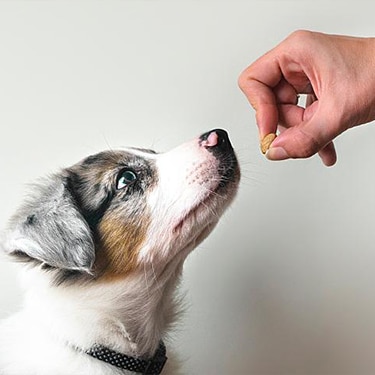
-
Find the right food for your petTake this quiz to see which food may be the best for your furry friend.Find the right food for your petTake this quiz to see which food may be the best for your furry friend.Featured products
 Adult Small Bites Chicken & Barley Recipe Dog Food
Adult Small Bites Chicken & Barley Recipe Dog FoodSupports lean muscle for dogs who prefer smaller kibble
Shop Now Adult Sensitive Stomach & Sensitive Skin Variety Pack Pouches (Chicken Stew & Turkey Stew)
Adult Sensitive Stomach & Sensitive Skin Variety Pack Pouches (Chicken Stew & Turkey Stew)Supports digestive health, nourishes skin and promotes a lustrous coat
Shop Now Adult 7+ Senior Vitality Chicken & Vegetable Stew Dog Food
Adult 7+ Senior Vitality Chicken & Vegetable Stew Dog FoodNutrition that helps a senior dog's everyday ability to get up and go
Shop NowFeatured products Adult 7+ Indoor Chicken Recipe Cat Food
Adult 7+ Indoor Chicken Recipe Cat FoodSupports energy level and beautiful fur in mature indoor cats
Shop Now Senior Vitality Adult 7+ Tuna & Vegetables Stew
Senior Vitality Adult 7+ Tuna & Vegetables StewImproves Everyday Ability to Get Up & Go
Shop Now Adult Turkey & Liver Entrée Cat Food
Adult Turkey & Liver Entrée Cat FoodPrecisely balanced nutrition with the delicious taste of minced turkey & liver to help fuel the energy needs of cats during the prime of their life
Shop Now -
Dog
- Dog Tips & Articles
-
Health Category
- Weight
- Food & Environmental Sensitivities
- Urinary
- Digestive
- Joint
- Kidney
-
Life Stage
- Puppy Nutrition
- Adult Nutrition
- Senior Nutrition
Cat- Cat Tips & Articles
-
Health Category
- Weight
- Skin & Food Sensitivities
- Urinary
- Digestive
- Kidney
-
Life Stage
- Kitten Nutrition
- Adult Nutrition
Featured articles The Science Behind Our Love for Pets
The Science Behind Our Love for PetsLearn the scientific reasons why we have such strong connections with our pets, and what science says about the love between humans and our furry friends.
Read More What Is Littermate Syndrome? Pet Adoption Guide
What Is Littermate Syndrome? Pet Adoption GuideLearn more about littermate syndrome in dogs and cats and how to successfully navigate adoption and early socialization processes.
Read More How to Properly Mix Wet & Dry Pet Foods
How to Properly Mix Wet & Dry Pet FoodsAn Orange cat eating from a bowl filled with mixed food
Read More -



There are few things in life cuter than seeing your terror-of-a-puppy dressed up in horns and a red cape on Halloween. But for dogs and their families, Halloween should also be a time for caution. To ensure that both your children and dogs enjoy a fun and safe holiday, please remember the following tips:
- Your dog can easily become anxious and frightened when the doorbell is constantly ringing and all he sees are children in strange clothes and masks. Confining him to his own safe haven for the evening (like his crate or a closed room) can help calm his nerves and prevent him from running out of the constantly opening front door.
- If you walk your dog around the neighborhood while children are trick-or-treating, be sure to use a sturdy collar, or harness and leash, and be careful around unfamiliar children and adults. Again, the costumes and masks may make your dog uncomfortable and frightened.
- Be sure your dog is wearing identification tags with your name and phone number on them in case you become separated from your dog or he escapes from the house.
- If you're dressing your dog for Halloween, use safe, non-flammable and non-toxic items that your dog is comfortable in and that don't restrict his movement, breathing or vision.
- Lastly, keep all candy out of your dog's reach — especially chocolate, which is toxic to dogs. Consumption of even small amounts can cause seizures, muscle tremors and vomiting while larger doses can be fatal. Stick to his own treats and he'll be just as happy.
Following these simple tips will help keep your dog safe, healthy and out of any scary trouble this Halloween.


Tasty Tips
Related products

Supports digestive health, nourishes skin and promotes a lustrous coat

Nutrition that helps a senior dog's everyday ability to get up and go

Chicken & Rice Stew with great taste and precisely balanced nutrition to support 5 essential building blocks for lifelong health

Supports lean muscle for dogs who prefer smaller kibble
Related articles

Learn how to help keep your dog's immune system in tip-top shape, including nutritional immune system support for dogs and other strategies.

Wondering where can I buy a dog? Consider adoption and explore the pros and cons of adopting a dog from a breeder versus an animal shelter.

Can puppies have treats? Explore best practices for giving your puppy treats to ensure you're doing so in the healthiest way possible.

Discover how the field of dog science is giving us more and more insights into the inner workings of our furry best friends.

Put your dog on a diet without them knowing
Our low calorie formula helps you control your dog's weight. It's packed with high-quality protein for building lean muscles, and made with purposeful ingredients for a flavorful, nutritious meal. Clinically proven antioxidants, Vitamin C+E, help promote a healthy immune system.
Put your dog on a diet without them knowing
Our low calorie formula helps you control your dog's weight. It's packed with high-quality protein for building lean muscles, and made with purposeful ingredients for a flavorful, nutritious meal. Clinically proven antioxidants, Vitamin C+E, help promote a healthy immune system.


